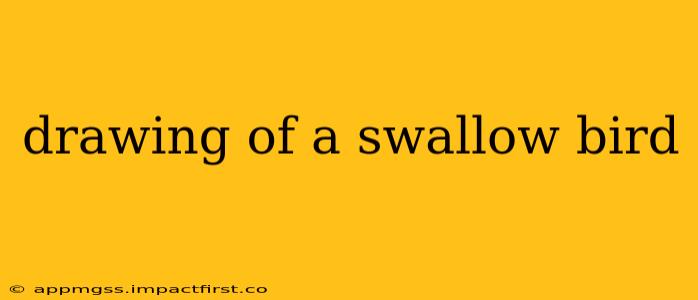Swallows, with their sleek bodies and acrobatic flight, are captivating subjects for artists of all levels. This guide will walk you through the process of drawing a swallow, from basic shapes to adding intricate details. Whether you're a seasoned artist or just starting out, you'll find helpful tips and techniques to capture the essence of this graceful bird.
What Materials Will I Need?
Before you begin, gather your materials. You'll need:
- Pencil: A range of pencils (e.g., H2, HB, 2B) will allow you to create different line weights and shading effects.
- Eraser: A kneaded eraser is ideal for lifting pencil marks without damaging the paper.
- Paper: Use drawing paper that is smooth enough for fine detail work, but with enough tooth to hold the pencil marks.
- Sharpener: Keep your pencils sharp for precise lines.
- Optional: Colored pencils, markers, or paints for adding color.
Step-by-Step Guide to Drawing a Swallow
1. Basic Shapes: Start by sketching lightly with your HB pencil. Think of the swallow's body as a series of simple shapes:
- Head: A small circle or oval.
- Body: A slightly elongated teardrop shape.
- Wings: Two elongated triangles, slightly curved.
- Tail: A forked shape, with two long, pointed streamers.
Lightly connect these shapes to create the basic outline of the swallow. Don't worry about making it perfect at this stage – it's just a guide.
2. Refining the Outline: Once you have the basic shapes in place, start to refine the outline. Pay attention to the curves of the bird's body, the sweep of its wings, and the length of its tail. Gradually erase the initial guide lines as you create a more detailed outline.
3. Adding Details: Now it's time to add finer details. This includes:
- Beak: A small, pointed beak.
- Eyes: Tiny, dark circles.
- Legs: Small, barely visible legs tucked under the body.
- Feather Details: Suggest the texture of the feathers with short, light strokes. Focus on the wing shape, particularly around the flight feathers, for accuracy.
4. Shading and Texture: Use shading to give your swallow a three-dimensional appearance. Observe how light falls on the bird's body and wings. Use darker shades in the areas where the light doesn't directly reach and lighter shades in areas where the light hits directly. Blend your shading gently using your finger or a blending stump.
5. Final Touches: Review your drawing, making any necessary adjustments. You can add subtle highlights to emphasize certain areas and enhance the overall realism.
What are the Different Types of Swallows?
There are many different types of swallows, each with slightly different markings and characteristics. Some of the most common include:
- Barn Swallow: Known for its long, forked tail and reddish-brown chest.
- Cliff Swallow: Features a brown cap and a pale rump.
- Tree Swallow: Distinguished by its iridescent blue-green back and white belly.
- Bank Swallow: Generally a more plain brown and white swallow.
Observing real-life photos or videos of different swallows can be incredibly helpful for accurately depicting details in your drawing.
How Do I Draw a Swallow in Flight?
Drawing a swallow in flight requires capturing the dynamic movement of its wings and body. Focus on the angles of the wings and the position of the body in relation to them. Observe how the wings create curves and S-shapes in mid-flight. Don't be afraid to use motion lines to suggest movement.
What are Some Tips for Drawing Birds in General?
- Reference Photos: Use reference photos for accurate details.
- Study Anatomy: Understanding bird anatomy will help you draw them more realistically.
- Practice: The more you practice, the better you'll become.
By following these steps and practicing regularly, you will be able to create a realistic and captivating drawing of a swallow. Remember to have fun and let your creativity shine!
